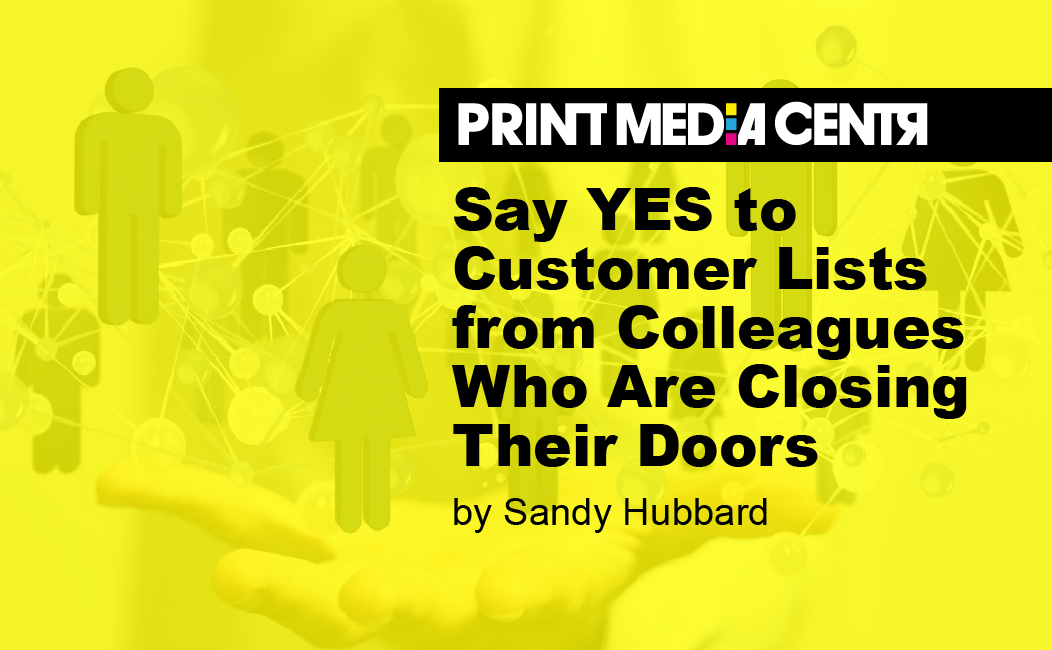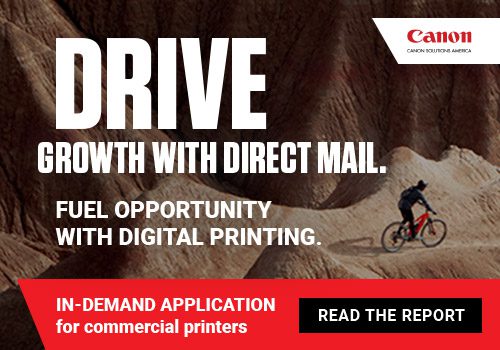When the magazine I ran for 22 years closed its doors, the owners offered me all the business data and customer lists for free. They were not going to do anything with it, and everything would be purged by the end of the tax year.
So I said yes.
Saying yes not only gave me valuable customer data, it gave me premium access to customers and the authority to approach them.
If someone going out of business offers you their customer list for free, say yes! Whether you’re a salesperson or business owner, data is good.

Over the past year, three of my retail clients closed their doors. Closing a business is a heart-wrenching experience. My clients wanted to be sure they were going out on a noble note and that their customers would be taken care of. They wanted to hand their data to someone who would appreciate it and deserve it.
My newest client previously worked at a popular organic farm supply store that served a broad market. My client has narrowed in on one segment and has become a “chicken consultant,” helping small organic farms and backyard chicken owners. Not everyone who shopped at her former company will want to cultivate chickens, but some will — and others may refer business her way.
When clients ask if they should accept the offer of a customer list from a colleague or former boss, I reply, “But of course, why not?”
Here’s what I’ve discovered about that.
Some people striking out on their own after working at a company that closed tell me they want to prove themselves on their own. Some think they are taking advantage of a sad situation and don’t realize they are actually helping the former business. Some don’t want to “contaminate” themselves with anything from a company that didn’t make it. Others just don’t realize what a valuable asset they are being offered.
In my own case, many other publications and consultants swooped in and asked for that data. Once I saw how many people wanted it, I said yes, even though I told myself I was not going to need it. After all, the customer list was already in my own CRM, so why would I need data from the bookkeeping system?
Well, my friends, there is nothing like being officially handed the keys to the car. A sanctioned transition of data is like gold.
My former company generously shared the emails of all the people who contacted them after the closure. They cc’d me on their replies, telling people to contact me directly. Awesome!
Say yes.
When you accept data from another company, it’s important to:
- Accept this gift graciously!
- Get something IN WRITING that the person giving you the list has the right to do so.
- Do NOT intermingle the list with yours. Store it offline until you can evaluate it safely. For the time being, this customer data, will be used for research and insight in view-only mode.
- Ask for the data in as many forms as possible. You are not being a greedy if you ask for lists in the forms most helpful to you.
- Follow all the data disclosure and usage laws and consumer protections that cover your jurisdiction and the jurisdiction of the company that is sharing data with you.
These are the customer lists you should ask for:
- THE “ALL-CUSTOMER” LIST. This is generated out of the accounts receivable program. It is a list of every customer going back to the start of the business. If they ask which columns/fields you want, say “All” which will give you the contact information (which may not be current) along with some account history such as creditworthy status.
- ACCOUNTS RECEIVABLE LIST with the receivables going out to 120 days. These are the current customers.
- BAD DEBT / BAD GUYS / DO NOT CALL LIST going back to the beginning of time. You don’t want to chase these kinds of customers.
- MAIL LIST from their mailing service that has been cleaned (most recent). This list will have the current data from the USPS and will be formatted correctly.
- EMAIL LIST downloaded from their email service provider. Don’t just take a list of email addresses unless it has the opt-outs and spam reports included. If you upload that data at some point into your own email program, you will have to aver that you have rights to the data and the recipients have opted in. Proceed carefully with email addresses. Always get permission in writing if you use a password to access the data yourself.
- SALES LISTS — exported from their CRM by salesperson’s name — with all contact info, notes, and phone/mobile numbers.
- CONTRACTS and purchase orders, old and current. Customers who sign contracts can go to the head of the line when you follow up with this data.
- PEOPLE WHO PAY BY CREDIT CARD — not the numbers, just the customers who prefer to pay this way. Even if the amounts are not large, these people have the authority to make a purchase.
- MASTER PROSPECT LIST with all columns/fields exported. Often you’ll find that the prospecting footwork has partially opened some doors for you. In my new client’s case, she didn’t even think about local plant nurseries as a potential source of referrals until she saw it on a list.
Each of these lists can give you sales insight. If you are going to pursue any of the customers, start with the low hanging fruit. Loyal customers who pay their bills promptly. Customers who cheerfully interact on social channels and refer business generously. Customers who answer their phones and reply to emails rather than going dark. Customers who spend lots of money, regularly.
Once you have agreed, don’t delay in the transfer of data.
If this business offering you the customer data is closing, their bookkeeper or sales assistant will be busy with many other closure tasks. This is the person who can most easily get you the data successfully. You’ll need to be pleasantly persistent to stay on their radar and receive the data before the company is fully closed and that person is gone. Follow through on their requests, use a secure server for file transfer if you can, acknowledge receipt, and keep the communication open and professional during this process. Check files promptly as you receive them to make sure they open and fields are filled. Download files to a safe location and archive all documentation.
Businesses are morphing right now. Is there a printing competitor who is on the brink of going out of business or struggling to serve their customers? Once a business is gone or being managed, say, by the bank or bankruptcy attorney, the process of acquiring assets becomes much more complicated and expensive. Is there a customer such as a print broker who has changed course and their list is sitting there unused? Now is the time to step in and have that conversation. Show character, integrity, and a sincere desire to help. You will be surprised at how easy it is to acquire customer lists for free or a modest charge.
Keep your eyes open for opportunities, and say yes to lists. Feel free to leave a comment or experience below,
Keep it flowing, friends!
 Sandy Hubbard is an expert Marketing Strategist specializing in the Printing Industry. She consults with Print CEOs and owners of print, media, and platform businesses of all sizes — helping marketing teams build visibility and increase sales.
Sandy Hubbard is an expert Marketing Strategist specializing in the Printing Industry. She consults with Print CEOs and owners of print, media, and platform businesses of all sizes — helping marketing teams build visibility and increase sales.
Sandy is also co-host of #PrintChat, a weekly discussion on LinkedIn. Join the group here — and enjoy the fun at social media’s most popular chat for the global printing industry!












